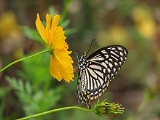
Chilasa clytia
Encyclopedia
The Common Mime, Papilio clytia, is a Swallowtail butterfly
found in South and South-east Asia. The butterfly belongs to the Chilasa group or the Black-bodied Swallowtails. It serves an excellent example of a Batesian mimic
among the Indian butterflies.
 Both males and females have the upperside velvety black or soft dark brown.
Both males and females have the upperside velvety black or soft dark brown.
Forewing: a subterminal series of outwardly truncate or emarginate white spot; the spot in interspace 4 shifted inwards out of line; those in interspaces 6,7 and 8 oblique to the costa, the lowest and the upper two spots elongate; this is followed by a terminal series of smaller white spots, two in interspace 1, one above the outer, and two in interspaces 8; lastly, a single spot between the subterminal and terminal series.
Hindwing: a discal series of inwardly conical and outwardly emarginate, triangular, elongate white spots; a prominent tornal yellow spot broadly divided across the middle by a bar of the ground colour. The cilia touched with white in the interspaces; sometimes one or more of these specks on the cilia are broad and prominent and yellow in colour.
Underside: from soft pale brown to rich dark velvety brown.
Forewing with the markings as on the upperside.
Hindwing: the markings also similar to those on the upperside, but the terminal margin beyond the subterminal series of white markings bears a row of comparatively large very conspicuous yellow spots, separated from the white lunules by a series of short transverse detached spots of the ground colour. Antennae, head, thorax and abdomen black, the thorax anteriorly and beneath and the abdomen on the sides spotted with white.
_on_jatropha_panduraefolia_in_kolkata_iws_img_0217.jpg)
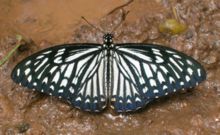 Form dissimilis, Doubleday differs from the first form as follows:
Form dissimilis, Doubleday differs from the first form as follows:
Upperside, forewing: cell with four streaks coalescent at base and four spots beyond at apex, a long streak in interspace 1a, two streaks with two spots beyond which are more or less coalescent with them in interspace 1, a broad streak with an outwardly emarginate spot in interspace 2, similar spots, one at base and one beyond, in 3, a single similar spot in 4, elongate streaks in 5 and 6, and much smaller elongate spots in interspaces 8 and 9. All these streaks and spots cream-white with diffuse edges; subterminal and terminal markings as in the first form.
Hindwing: markings similar to those in the first form with the following differences: discoidal cell entirely white, discal white streaks longer that reach quite up to the outer margin of the cell and are continued anteriorly to the costa by elongate streaks in interspaces 6 and 7, two spots in interspace 8 and a slender streak along the costa; the subterminal and terminal markings as in the first form.
Underside similar to the upperside, the cream-white markings slightly larger, the terminal series of yellow spots on the hindwing as in the first form. Antennae, head, thorax and abdomen as in the typical clytia form; the head, thorax and abdomen with more prominent white spots.
Wing expanse: 108–121 mm
from Kangra to Sikkim
, from Assam
to Burma, Nepal
, Bangladesh
, Peninsular India and the Andaman Islands
. It is also found in Sri Lanka
, Thailand
, Southern China (including Hainan
), Hong Kong
, Vietnam
, Laos
, Kampuchea, peninsular Malaysia, Philippines
and Indonesia
(Flores
, Alor
, Timor
and Moa
). Several regional variants and forms are recognized.
(Euploea core) while the form dissimilis mimics the Blue Tiger
(Tirumala limniace).
The flight of the Mime also resembles that of the model, fluttering, neither weak nor strong, sometimes staying close to the ground and at other times flying strongly up into the treetops. It mud-puddles on stream banks in summer. Known to bask and usually sits with the wings spread wide open while feeding on nectar from flowers.
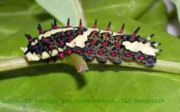
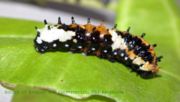 The larvae and pupa are stated by Mackinnon to resemble closely the larva and pupa of P. agestor'. Messrs. Davidson and Aitken's description of them is as follows:
The larvae and pupa are stated by Mackinnon to resemble closely the larva and pupa of P. agestor'. Messrs. Davidson and Aitken's description of them is as follows:
"Not unlike the larva of the Ornithoptera group in form, having similar rows of fleshy processes, but it is by far the handsomest Papilio larva we know, being of a dark umber-brown colour with a bright red spot at the base of each process, a dorsal row of large irregular yellow patches and a partial lateral row ending in a diagonal band which connects the two."
velvet black or dark green. Has carmine spots. Has a dark red-brown longitudinal band and red spots. Two rows of sharp spines on segments 1 to 4 and single row on the others. The Osmeterium
is light indigo-blue.

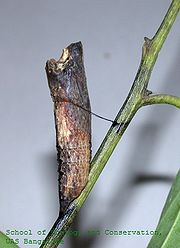 "is unique, exhibiting one of the most remarkable instances of protective resemblance we know. It exactly resembles a dead twig about an inch long and less than a quarter of an inch in diameter, broken of irregularly at one end. The last segment is so modified that the pupa is not attached by one point, but appears as if it had grown out of the branch to which it affixes itself."
"is unique, exhibiting one of the most remarkable instances of protective resemblance we know. It exactly resembles a dead twig about an inch long and less than a quarter of an inch in diameter, broken of irregularly at one end. The last segment is so modified that the pupa is not attached by one point, but appears as if it had grown out of the branch to which it affixes itself."
An inch in length, brownish with streaks and blotches. Rough surface with tubercles. Has uncanny resemblance to a broken twig and is suspended at an appropriate angle.
Swallowtail butterfly
Swallowtail butterflies are large, colorful butterflies that form the family Papilionidae. There are over 550 species, and though the majority are tropical, members of the family are found on all continents except Antarctica...
found in South and South-east Asia. The butterfly belongs to the Chilasa group or the Black-bodied Swallowtails. It serves an excellent example of a Batesian mimic
Mimic
In evolutionary biology, mimicry is the similarity of one species to another which protects one or both. This similarity can be in appearance, behaviour, sound, scent and even location, with the mimics found in similar places to their models....
among the Indian butterflies.
Form clytia

Forewing: a subterminal series of outwardly truncate or emarginate white spot; the spot in interspace 4 shifted inwards out of line; those in interspaces 6,7 and 8 oblique to the costa, the lowest and the upper two spots elongate; this is followed by a terminal series of smaller white spots, two in interspace 1, one above the outer, and two in interspaces 8; lastly, a single spot between the subterminal and terminal series.
Hindwing: a discal series of inwardly conical and outwardly emarginate, triangular, elongate white spots; a prominent tornal yellow spot broadly divided across the middle by a bar of the ground colour. The cilia touched with white in the interspaces; sometimes one or more of these specks on the cilia are broad and prominent and yellow in colour.
Underside: from soft pale brown to rich dark velvety brown.
Forewing with the markings as on the upperside.
Hindwing: the markings also similar to those on the upperside, but the terminal margin beyond the subterminal series of white markings bears a row of comparatively large very conspicuous yellow spots, separated from the white lunules by a series of short transverse detached spots of the ground colour. Antennae, head, thorax and abdomen black, the thorax anteriorly and beneath and the abdomen on the sides spotted with white.
Form dissimilis
_on_jatropha_panduraefolia_in_kolkata_iws_img_0217.jpg)

Upperside, forewing: cell with four streaks coalescent at base and four spots beyond at apex, a long streak in interspace 1a, two streaks with two spots beyond which are more or less coalescent with them in interspace 1, a broad streak with an outwardly emarginate spot in interspace 2, similar spots, one at base and one beyond, in 3, a single similar spot in 4, elongate streaks in 5 and 6, and much smaller elongate spots in interspaces 8 and 9. All these streaks and spots cream-white with diffuse edges; subterminal and terminal markings as in the first form.
Hindwing: markings similar to those in the first form with the following differences: discoidal cell entirely white, discal white streaks longer that reach quite up to the outer margin of the cell and are continued anteriorly to the costa by elongate streaks in interspaces 6 and 7, two spots in interspace 8 and a slender streak along the costa; the subterminal and terminal markings as in the first form.
Underside similar to the upperside, the cream-white markings slightly larger, the terminal series of yellow spots on the hindwing as in the first form. Antennae, head, thorax and abdomen as in the typical clytia form; the head, thorax and abdomen with more prominent white spots.
Wing expanse: 108–121 mm
Other forms
Many variations have been described and given names in the past, and many of these names may no longer be valid.- Variety casyapa, Moore - "Forewings, besides the marginal and submarginal markings with a third discal series of one to five markings." (Rothschild quoted in Bingham)
- Variety papone, Westwood - "Forewings black, with an obvious bluish tint in certain lights; the white spots absent from the forewings or only faintly indicated." (Rothschild quoted in Bingham)
- Variety commixtus, Rothschild- "Forewings black or bluish black, with a marginal, submarginal and a subdiscal series of most feebly marked spots, and with two faint spots behind the cell and a streak along the inner margin (dorsum) white; the discal markings are often indicated by a few white scales, or are entirely absent. Hindwings with apical half of the cells, seven long discal streaks reaching the base of the respective cellules (interspaces?) ( the first and the last reach the base of the wing) and a marginal and submarginal series of spots white as in ab. dissimils, L. This aberration and examples intermediate between it and clytia I received from the Khasia Hills." (Rothschild quoted in Bingham)
- Race lankeswara (Sri Lanka) Moore- "Differs from P. clytia in the umber-brown colour of the wings and in the small submarginal spots of the fore wings; from P. clytia panope, it is distinguished chiefly by the longer discal sagittiform spots of the hindwings. This subspecies has been described from slightly aberrant specimens in which the submarginal spots of the forewings are partly obliterated; in most individuals the series of these spots is complete, and on such specimens Moore's clytioides is based." (Rothschild quoted in Bingham) The dimorph or dissimilis form of this race is identical with that of P. clytia.
- Race panope, Linn. (Myanmar and into Siam and the Malay Peninsula) - "The discal sagittate spots of the hindwings are shorter than in P. clytia, sometimes they have almost disappeared from the upperside. Most frequently the marginal and submarginal markings of the forewings are more or less merged together, and form in the apex of the wing three large patches." (Rothschild quoted in Bingham) The dimorph or dissimilis form of this race also resembles that of the typical form.
- Variety janus, FruhstorferHans FruhstorferHans Fruhstorfer was a German explorer, insect trader and entomologist who specialised in Lepidoptera. He collected and described many new species of exotic butterflies, especially in Seitz's Macrolepidoptera of the World...
- The subterminal and terminal white markings on the forewings only faintly indicated or replaced by small black spots centred sometimes with obscure white. The white sagittate subterminal markings with obscure white. The white sagittate subterminal markings on the hindwing are in most specimens small and obscured by an irroration of dark scales.
- Race flavolimbatus, Oberthür (The Andamans) - Closely resembles the dissimils form of clytia; differs as follows: both males and females distinctly larger, the white markings similar but proportionately larger, with the exception of the streaks in the discoidal cells of both fore and hindwings, which are narrower and less firmly defined; on the hindwing there is a terminal row of ochraceous-yellow spots on the upper as well as on the underside, while those on the underside are very much larger than in P. clytia, dimorph dissimilis. The dark form clytia or any race of it is apparently unknown in the Andamans.
Distribution
This butterfly is found in IndiaIndia
India , officially the Republic of India , is a country in South Asia. It is the seventh-largest country by geographical area, the second-most populous country with over 1.2 billion people, and the most populous democracy in the world...
from Kangra to Sikkim
Sikkim
Sikkim is a landlocked Indian state nestled in the Himalayan mountains...
, from Assam
Assam
Assam , also, rarely, Assam Valley and formerly the Assam Province , is a northeastern state of India and is one of the most culturally and geographically distinct regions of the country...
to Burma, Nepal
Nepal
Nepal , officially the Federal Democratic Republic of Nepal, is a landlocked sovereign state located in South Asia. It is located in the Himalayas and bordered to the north by the People's Republic of China, and to the south, east, and west by the Republic of India...
, Bangladesh
Bangladesh
Bangladesh , officially the People's Republic of Bangladesh is a sovereign state located in South Asia. It is bordered by India on all sides except for a small border with Burma to the far southeast and by the Bay of Bengal to the south...
, Peninsular India and the Andaman Islands
Andaman Islands
The Andaman Islands are a group of Indian Ocean archipelagic islands in the Bay of Bengal between India to the west, and Burma , to the north and east...
. It is also found in Sri Lanka
Sri Lanka
Sri Lanka, officially the Democratic Socialist Republic of Sri Lanka is a country off the southern coast of the Indian subcontinent. Known until 1972 as Ceylon , Sri Lanka is an island surrounded by the Indian Ocean, the Gulf of Mannar and the Palk Strait, and lies in the vicinity of India and the...
, Thailand
Thailand
Thailand , officially the Kingdom of Thailand , formerly known as Siam , is a country located at the centre of the Indochina peninsula and Southeast Asia. It is bordered to the north by Burma and Laos, to the east by Laos and Cambodia, to the south by the Gulf of Thailand and Malaysia, and to the...
, Southern China (including Hainan
Hainan
Hainan is the smallest province of the People's Republic of China . Although the province comprises some two hundred islands scattered among three archipelagos off the southern coast, of its land mass is Hainan Island , from which the province takes its name...
), Hong Kong
Hong Kong
Hong Kong is one of two Special Administrative Regions of the People's Republic of China , the other being Macau. A city-state situated on China's south coast and enclosed by the Pearl River Delta and South China Sea, it is renowned for its expansive skyline and deep natural harbour...
, Vietnam
Vietnam
Vietnam – sometimes spelled Viet Nam , officially the Socialist Republic of Vietnam – is the easternmost country on the Indochina Peninsula in Southeast Asia. It is bordered by China to the north, Laos to the northwest, Cambodia to the southwest, and the South China Sea –...
, Laos
Laos
Laos Lao: ສາທາລະນະລັດ ປະຊາທິປະໄຕ ປະຊາຊົນລາວ Sathalanalat Paxathipatai Paxaxon Lao, officially the Lao People's Democratic Republic, is a landlocked country in Southeast Asia, bordered by Burma and China to the northwest, Vietnam to the east, Cambodia to the south and Thailand to the west...
, Kampuchea, peninsular Malaysia, Philippines
Philippines
The Philippines , officially known as the Republic of the Philippines , is a country in Southeast Asia in the western Pacific Ocean. To its north across the Luzon Strait lies Taiwan. West across the South China Sea sits Vietnam...
and Indonesia
Indonesia
Indonesia , officially the Republic of Indonesia , is a country in Southeast Asia and Oceania. Indonesia is an archipelago comprising approximately 13,000 islands. It has 33 provinces with over 238 million people, and is the world's fourth most populous country. Indonesia is a republic, with an...
(Flores
Flores
Flores is one of the Lesser Sunda Islands, an island arc with an estimated area of 14,300 km² extending east from the Java island of Indonesia. The population was 1.831.000 in the 2010 census and the largest town is Maumere. Flores is Portuguese for "flowers".Flores is located east of Sumbawa...
, Alor
Alor
Alor is the largest island in the Alor Archipelago located at the eastern-most end of the Lesser Sunda Islands that runs through southern Indonesia, which from the west include such islands as Bali, Lombok, Sumbawa, Komodo, and Flores....
, Timor
Timor
Timor is an island at the southern end of Maritime Southeast Asia, north of the Timor Sea. It is divided between the independent state of East Timor, and West Timor, belonging to the Indonesian province of East Nusa Tenggara. The island's surface is 30,777 square kilometres...
and Moa
Moa
The moa were eleven species of flightless birds endemic to New Zealand. The two largest species, Dinornis robustus and Dinornis novaezelandiae, reached about in height with neck outstretched, and weighed about ....
). Several regional variants and forms are recognized.
Status
Generally common and not threatened. The nominate subspecies is protected by law in India.Habitat
This is a butterfly of hilly regions but also found at lower elevations. It is plentiful in the premonsoon and monsoon period and becomes scarce later on.Habits
The Common Mime has two mimetic forms in both sexes. The nominate form C. clytia form clytia mimics the Common Indian CrowEuploea core
The Common Crow is a common butterfly found in South Asia. In India it is also sometimes referred to as the Common Indian Crow, and in Australia as the Australian Crow. It belongs to the Crows and Tigers subfamily of the Nymphalidae .The Common Crow is the most common representative of its genus...
(Euploea core) while the form dissimilis mimics the Blue Tiger
Tirumala limniace
The Blue Tiger is a butterfly found in India that belongs to the Crows and Tigers, that is, the Danaid group of the Brush-footed butterflies family. This butterfly shows gregarious migratory behaviour in southern India.-Description:...
(Tirumala limniace).
The flight of the Mime also resembles that of the model, fluttering, neither weak nor strong, sometimes staying close to the ground and at other times flying strongly up into the treetops. It mud-puddles on stream banks in summer. Known to bask and usually sits with the wings spread wide open while feeding on nectar from flowers.
Larval host plants
The larvae feed on species of the Laurel family LauraceaeLauraceae
The Lauraceae or Laurel family comprises a group of flowering plants included in the order Laurales. The family contains about 55 genera and over 3500, perhaps as many as 4000, species world-wide, mostly from warm or tropical regions, especially Southeast Asia and South America...
- Alseodaphne semicarpifolia
- Cinnamomum camphora
- Cinnamonum macrocarpum
- Litsea chinensis
- Litsea deccansis
- Tetranthera apetala
Larva


"Not unlike the larva of the Ornithoptera group in form, having similar rows of fleshy processes, but it is by far the handsomest Papilio larva we know, being of a dark umber-brown colour with a bright red spot at the base of each process, a dorsal row of large irregular yellow patches and a partial lateral row ending in a diagonal band which connects the two."
velvet black or dark green. Has carmine spots. Has a dark red-brown longitudinal band and red spots. Two rows of sharp spines on segments 1 to 4 and single row on the others. The Osmeterium
Osmeterium
The osmeterium is a fleshy organ found in the prothoracic segment of larvae of Swallowtail butterflies including Birdwings. This organ emits smelly compounds believed to be pheromones. Normally hidden, this forked structure can be everted when the caterpillar is threatened, and used to emit a...
is light indigo-blue.
Pupa


An inch in length, brownish with streaks and blotches. Rough surface with tubercles. Has uncanny resemblance to a broken twig and is suspended at an appropriate angle.
Key to forms
From Bingham, C. T. (1907) The Fauna of British India, Including Ceylon and Burma. Butterflies. Vol 2- A. Forewing upperside: not glossed with blue, or if blue-glossed, then wing uniform without other markings.
- a. Basal half or more of both fore and hind wing uniform without white markings.
- a1. Forewing upperside: no blue gloss at base.
- a2. Forewing uppserisde with prominent subterminal and terminal, sometimes also a postdiscal, series of white spots.
- a3. These spots not elongate, not coalescent towards apex and not formed into a prominent apical white patch.
- P. clytia
- b3. These spots elongate and coalescent towards apex and there form a prominent white patch.
- P. clytia race panope
- a3. These spots not elongate, not coalescent towards apex and not formed into a prominent apical white patch.
- b2. Forewing upperside without or with only more or less obsolescent series of subterminal and terminal white spots; such spots when present always very small.
- P. clytia race lankeswara
- a2. Forewing uppserisde with prominent subterminal and terminal, sometimes also a postdiscal, series of white spots.
- b1. Forewing upperside with a more or less obvious blue gloss at base.
- P. clytia variety papone
- a1. Forewing upperside: no blue gloss at base.
- b. Basal half of fore and hind wing not uniform, with a streak in cell and in posterior interspaces.
- a1. Hindwing upperside: discal series of white streaks broad and long; underside: terminal series of ochraceous-yellow spots not remarkably large.
- P. clytia dimorph dissimils
- b1. Hindwing upperside: discal series of white streaks short and narrow; underside: terminal series of ochraceous-yellow spots remarkably large.
- P. clytia race flavolimbatus
- a1. Hindwing upperside: discal series of white streaks broad and long; underside: terminal series of ochraceous-yellow spots not remarkably large.
- a. Basal half or more of both fore and hind wing uniform without white markings.
- B. Forewing upperside: richly glossed with blue.
- a. Hindwing: male without, female with, whitish streaks in cell and interspaces that extend up to base of wing.
- P. paradoxus race telearchus
- b. Hindwing: Male and female with white discal markings, but none that extend up to base of wing
- P. caunus race danisepa.
- a. Hindwing: male without, female with, whitish streaks in cell and interspaces that extend up to base of wing.
Other references
- Evans, W.H., (1932) The Identification of Indian Butterflies (2nd Ed), Bombay Natural History Society, Mumbai, India
- Gay, T., Kehimkar, I. & Punetha, J.C., (1992) Common Butterflies of India.WWF-India and Oxford University Press. Mumbai. India.
- Haribal, Meena (1992) The Butterflies of Sikkim Himalaya.Sikkim Nature Conservation Foundation, Gangtok
- Kunte, Krushnamegh (2000) Butterflies of Peninsular India. Universities Press, Hyderabad. ISBN 81-7371-354-5
- Wynter-Blyth, M.A., (1957) Butterflies of the Indian Region, Bombay Natural History Society, Mumbai, India.
External links
- http://www.angelfire.com/journal2/chinfahshin/history/mime.html
- ASEAN Biodiversity database

